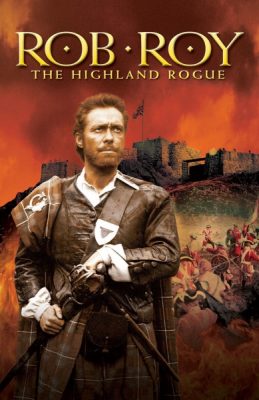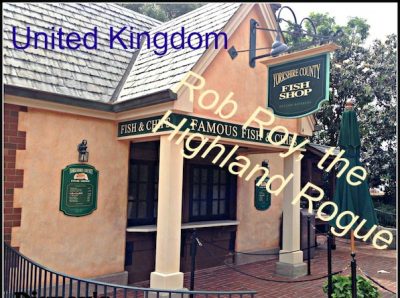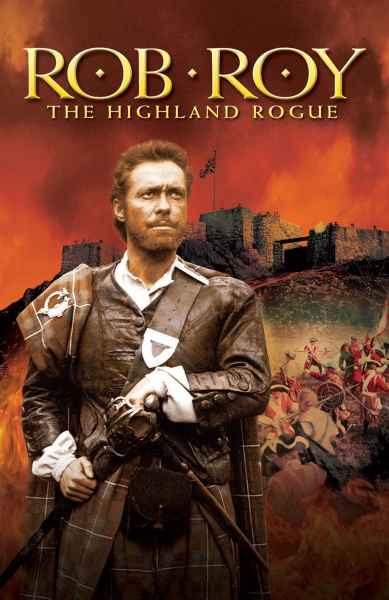
Based on the life of Scottish outlaw and folk hero Rob Roy MacGregor (1671-1734), Disney’s Rob Roy, the Highland Rogue was theatrically released on February 4, 1954. The live action drama is eighty-one minutes in length.
Rob Roy, the Highland Rogue was the last of four Disney films, following Treasure Island (1950), The Story of Robin Hood and His Merrie Men (1952), and The Sword and the Rose (1953), to be produced in the United Kingdom such as to utilize funds frozen in Europe after World War II. Additionally, Rob Roy was the final Disney film to be distributed by RKO Pictures, which had distributed Disney films since Snow White and the Seven Dwarfs in 1937. (1) Henceforth, Disney distributed the company’s films through its own Buena Vista Film Distribution Company, which was formed after Walt Disney encountered problems with RKO over the distribution of the installments of his True-Life Adventures nature documentary series. (2)
Plot Summary
In early-eighteenth-century Scotland, members of the various highland clans are trapped in a state of uncertainty. Infuriated that the German George I (Eric Pohlmann) has assumed the throne of England rather than James Stuart, the highland clans revolt in the Jacobite rising of 1715, battling British troops until only the clan led by Rob Roy MacGregor (Richard Todd) refuses to submit to George’s authority. Although the MacGregor clan shows unequivocal enthusiasm for its cause, the group’s sustenance is aided by the sympathy of John Campbell, Duke of Argyll (James Robertson Justice), a cousin of Rob Roy’s elderly mother (Jean Taylor Smith) and George I’s Secretary of State for Scotland, who refuses to unleash the maximum capacity of his troops against the MacGregors, an order that would likely have ended the conflict. Argyll’s restraint saves the MacGregor clan from extermination, but this caution angers officials in London, who replace Argyll as Secretary of State with the more provocative Duke of Montrose (Michael Gough). Montrose’s surly subordinate Killearn (Geoffrey Keen) proceeds to announce that King George has pardoned all participants in the recent uprisings save for the MacGregor clan. Indeed, Rob Roy is now the most wanted man in all of Great Britain.
Despite the precarious hold they maintain over their lives, Rob Roy; his mother; his wise new wife, Helen Mary MacPherson MacGregor (Glynis Johns); and the rest of the MacGregor clan hesitate to cease fighting, and even when they move towards submission, new provocations rekindle the flames of discontent. Pride notwithstanding, however, do the MacGregors really stand a chance to defeat an army of Redcoats and mercenaries that has not yet been fully utilized? Also, if such is not the case, would Rob Roy better serve the future of the Scottish highlanders by fully committing to peace, even if he must accept his own death?
Excess
Although fighting for one’s beliefs is a respectable endeavor, does there come a point when one should compromise some objectives and principles for the greater good? Rob Roy deals with this conundrum throughout the film.
In the film’s closing moments, King George affirms the virtue of fighting for principle by siding with the requests of the title character against the reservations of the royal officials, who George admits are self-interested in that they only care about maintaining political favor. The Duke of Argyll made similar comments about the ambitious Duke of Montrose on a couple of occasions earlier in the film, once prior to meeting with Rob Roy’s mother and once during that lady’s funeral. The dichotomy between principle and self-aggrandizement would contribute to the American Revolution later in the century after British placemen assumed increased roles in colonial affairs. (3)
Characterization
The characters in Rob Roy, the Highland Rogue largely appear with minimal context about their backgrounds and intentions. As such, sympathizing with the players is difficult, and the film’s action is more enjoyable than its plot.
Action
The main virtue of Rob Roy, the Highland Rogue is the flick’s plethora of action scenes, which commence immediately following the opening credits and persist throughout the effort. Along the way, viewers witness several extended battles between Scottish clansmen and opposing British troops; daring escapes by the title character from custody, including respective moments where Roy literally pulls the nose of the Duke of Montrose after a trap initiated by Roy’s mother successfully blocks the road, casually falls over a waterfall, swings across gaps like Tarzan, and kicks a gigantic boulder over the heads of approaching troops on a steep cliff; and Helen Mary’s energetic completion of a war story commenced by her elderly uncle Hamish MacPherson (Finlay Currie).
Interestingly, the soldiers seen in the various battle scenes were actual British soldiers, loaned to Disney by the Scottish Command of the British War Office following service in the Korean War. (4)
Humor
Rob Roy, the Highland Rogue is a drama, but the movie features several funny moments. For example, Hamish MacPherson interrupts a romantic dialogue between Rob Roy and Helen Mary with ear-piercing bagpipe noises, and George I struggles to comprehend a popular pamphlet about Rob Roy’s exploits.
Relationship to Other Disney Films
Glynis Johns had previously starred in The Sword and the Rose for Disney, and she subsequently contributed to Mary Poppins (1964) and The Ref (1994) for the studio. Johns was named a Disney Legend in 1998.
Richard Todd, who was named a Disney Legend in 2002, had previously starred in Treasure Island and The Sword and the Rose for Disney.
James Robertson Justice had previously appeared in The Story of Robin Hood and His Merrie Men and The Sword and the Rose for Disney.
Michael Gough had previously appeared as the antagonist, the Duke of Buckingham, in The Sword and the Rose.
Finlay Currie had previously appeared in Treasure Island for Disney, and he subsequently contributed to Kidnapped (1960) and The Three Lives of Thomasina (1963) for the studio. The latter two films, like Rob Roy, were set in Scotland.
Davy Crockett, King of the Wild Frontier (1955), Davy Crockett and the River Pirates (1956), Johnny Tremain (1957), and The One and Only, Genuine, Original Family Band (1968) were also based on noteworthy historical figures.
In the Parks
Scotland is part of the United Kingdom, and the United Kingdom is among the eleven nations represented in Epcot’s World Showcase.

Overall
Rob Roy, the Highland Rogue features lots of action, but the characters lack depth, and the plot is not overly suspenseful. Still, the effort is fairly brief and contains historical value, so it is worth a watch.
Notes
1) Steven Watts, The Magic Kingdom: Walt Disney and the American Way of Life (Columbia, Mo.: University of Missouri Press, 1997), 66, 373.
2) Ibid.
3) See, for example, James Haw, John and Edward Rutledge of South Carolina (Athens, Ga.: University of Georgia Press, 1997), 22-31.
4) Chelsea Wessels, “Cedric Thorpe Davie Composes the Score for Rob Roy: The Highland Rogue,” Cinema St Andrews, accessed May 11, 2018, http://cinemastandrews.org.uk/production/cedric-thorpe-davie-composes-the-score-for-rob-roy-the-highland-rogue/.
What do you think of Rob Roy, the Highland Rogue? Let me know in the comments!
Sponsored Ad: Would you like to help support The Mouse For Less website in continuing their mission of being THE Disney vacation planning resource? You can do so by purchasing Rob Roy, The Highland Rogue from our Affiliate Link through Amazon. Thanks so much for your support!
Did you like this article? Make sure to share it with your friends! Check below for easy ways to share!
Incoming search terms:
- Rob Roy: The Highland Rogue

